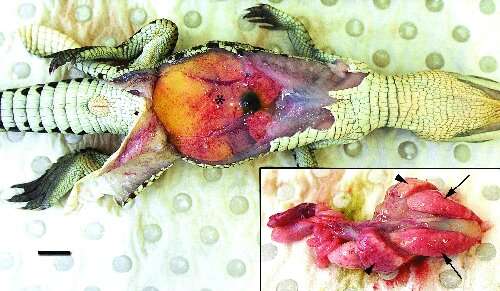Crocodile-killing bacteria identified by researchers

A groundbreaking study by a north Australian research team which identified a deadly bacterium responsible for killing saltwater crocodiles at a Top End Wildlife Park has recently been published in the journal, Microbial Genomics.
Led by Menzies School of Health Research (Menzies), the study investigated the deaths of two hatchling saltwater crocodiles at the Wildlife Park using high-resolution whole-genome sequencing and comparative phylogenetics.
The findings, which identified a common north Australian strain of melioidosis in the hatchlings incubator, changed previous thoughts that crocodiles were highly resistant to infection.
Melioidosis is a disease of humans and animal's endemic to Southeast Asia and northern Australia caused by the bacterium Burkholderia pseudomallei. Infection is normally acquired through cuts, ingestion of contaminated soil or water and inhalation, particularly during severe weather events.
Lead author, Menzies researcher, Ms Audrey Rachlin said that although melioidosis has been identified in a wide array of animal species, the last report of a saltwater crocodile being infected by the disease in the Top End was over 30 years ago.
"There is only a single report of infection of a crocodile in the Top End, and that was a limb wound occurring over 30 years ago," Ms Rachlin said.
"Our investigation into the two juvenile crocodiles combined epidemiological findings with high-resolution comparative genomics to determine the source of infection.
"B. pseudomallei sequence type ST-109, the most frequently identified and widely dispersed molecular type in the Top End was found to be responsible for infection in both animals.
"Collectively, the data enabled the study to identify the probable source of infection as the hatchling incubator."
According to Menzies' Tropical and Emerging Infections Diseases team leader, Professor Bart Currie, collaborative studies with veterinary colleagues have been essential to gaining a better understanding of melioidosis and the danger of the disease to humans.
"Darwin has the highest recorded rates of melioidosis of any city in the world. Fortunately, improvements in prevention, diagnosis and treatment have led to mortality rates reducing to 10 percent, compared to 30 percent in earlier years," Prof Currie said.
"This study of melioidosis in crocodiles has filled in more pieces of the puzzle for human melioidosis.
"This collaborative approach is a great example of a "One Health" approach to diseases of global significance for both animals and humans."
Study collaborator, Northern Territory (NT) Crocodile Park owner, Professor Grahame Webb, says the NT has played a pioneering role in the technical challenges of developing a crocodile farming industry, with this sometimes-involving issues related to human health.
"Working with Menzies has resulted in the crocodile industry implementing new operating procedures, which has helped both the health of the crocodiles and staff working with them.
"Having a world-class research facility on our door-step is profoundly important to our ability to pursue new and innovative economic development opportunities involving wild and domestic animals," Prof Webb said.
"Our ongoing work examining the phylogenetic relationships between other prevalent sequence types in the Top End will further improve knowledge of genotype diversification and patterns of dispersal in the environment for this highly pathogenic bacterium," Prof Currie continued.
"This has global biosecurity relevance given recent prediction mapping of melioidosis suggests substantial numbers of undetected cases and deaths are occurring in many countries and genotyping studies suggesting dispersal from Asia to Madagascar and from West Africa to Americas."
More information: Audrey Rachlin et al. A cluster of melioidosis infections in hatchling saltwater crocodiles (Crocodylus porosus) resolved using genome-wide comparison of a common north Australian strain of Burkholderia pseudomallei, Microbial Genomics (2019). DOI: 10.1099/mgen.0.000288
Provided by Menzies School of Health Research

















